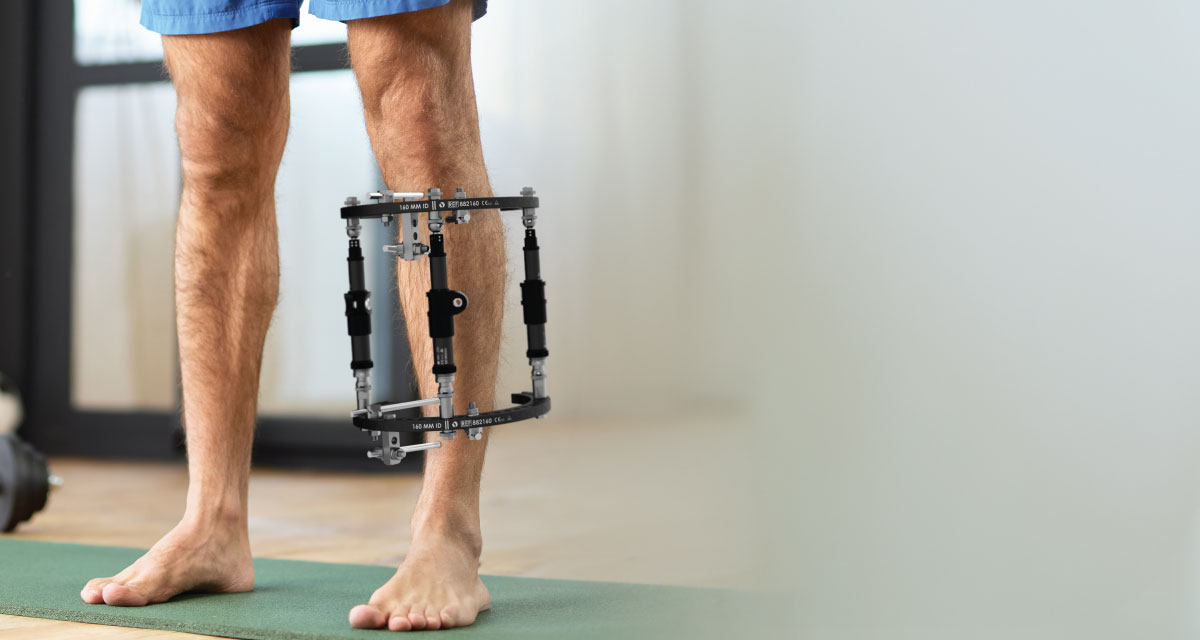The successful outcome of a deformity correction with external fixation surgery relies also on a meticulous post-operative management approach. It is critical to optimal healing and the restoration of functionality. Wound care, pain control, rehabilitation exercises, monitoring of complications, and regular follow-ups are integral to a faster recovery.[1]
External fixation can be applied in fracture correction involving the
percutaneous insertion of pins or wires from an external scaffold into the
fractured bone segments to secure them.
Indications for External Fixation
The procedure is advised for:
– Unstable pelvic ring injuries
– Complex fractures involving joints such as the pilon, distal femur, tibial plateau, elbow, and distal radius
– Fractures accompanied by significant soft tissue loss and swelling
– Hemodynamically unstable patients who are unable to undergo an open procedure
– Comminuted long bone fractures
– Limb deformities
– Limb lengthening
– Osteomyelitis
– Non-union or malunion
– Infected fractures.[1]
History and Types of External Fixators
External fixation surgery was first mentioned over 2000 years ago, by Hippocrates for immobilizing fractures by maintaining soft tissue integrity. Malgaigne introduced external fixation in 1853 as an alternative to plaster cast immobilization, traction, and internal fixation. The Ilizarov technique popularized circular external fixation with thin wires in the 1970s-80s.[1],[2]
External fixator types:
– Monolateral fixators: effective for long bone fractures, they offer stability against forces.
– Hybrid fixators: combine techniques for complex cases, harnessing benefits of different types.
– Ilizarov/Circular fixators: facilitate limb lengthening, used in deformity correction surgery.
– Mini fixators: used for smaller bones, like in pediatric cases.[3]
Weight-bearing with External Fixation
Weight-bearing refers to the amount of weight allowed or advised on the affected limb while it is treated with an external fixator. It is determined by factors such as fixator type, stability, fracture severity, and healing progress.
Benefits:
– Early weight-bearing and functional activity promote bone healing.
– Axial loading stimulates osteogenesis at the fracture or osteotomy site.
– Wires in external fixation allow axial motion, creating a “trampoline effect” during weight-bearing.
– This encourages bone growth and is important for postoperative management of deformity correction surgery.[4]
Note that the final decision on the amount of weight-bearing to be placed as well as the time points to initiate the process remain up to the surgeon and depend on a case-by-case basis.
Post-Operative Management Protocols for External Fixation Surgery
– Clean the fixator and limb regularly and use bulky wraps to control pin-skin motion.
– Apply topical antibiotics to reduce microbial contamination and place sterile gauze between the fixator and skin to absorb exudates and reduce swelling.
– Change the bandage frequency based on wound drainage.
– Conduct routine check-ups to inspect the wound, tighten the fixator, and take radiographs to monitor bone healing.
– Consider dynamization or weight-bearing to stimulate osteosynthesis.
– Remove the fixator only after clinical and radiographic confirmation of bone healing.
A successful external fixation surgery is dependent on the patient’s ability to strictly follow instructions and the clinician’s close supervision.[3],[5]
Challenges and Advantages of External Fixation
Possible complications of external fixation surgery:
– Pin site infections
– Pin loosening
– Patient pain
Benefits of external fixation surgery:
– Early mobilization
– Adjustable bone reduction
– Soft tissue preservation
– Versatility in treating difficult fractures
Careful monitoring and post-operative rehabilitation aid in overcoming challenges and improving outcomes.[3]
References
- Hadeed A, Werntz RL, Varacallo M. External Fixation Principles and Overview. [Updated 2023 Aug 4].
- Fragomen AT, Rozbruch SR. The mechanics of external fixation. HSS Journal®. 2007 Feb;3(1):13-29.
- Bakici M, Karslı B, Cebeci MT. External skeletal fixation. International Journal of Veterinary and Animal Research (IJVAR). 2019 Dec 31;2(3):69-73.
- Fragomen AT, Rozbruch SR. The mechanics of external fixation. HSS J. 2007 Feb;3(1):13-29. doi: 10.1007/s11420-006-9025-0
- Aron DN, Dewey CW. Application and postoperative management of external skeletal fixators. Vet Clin North Am Small Anim Pract. 1992 Jan;22(1):69-97.

